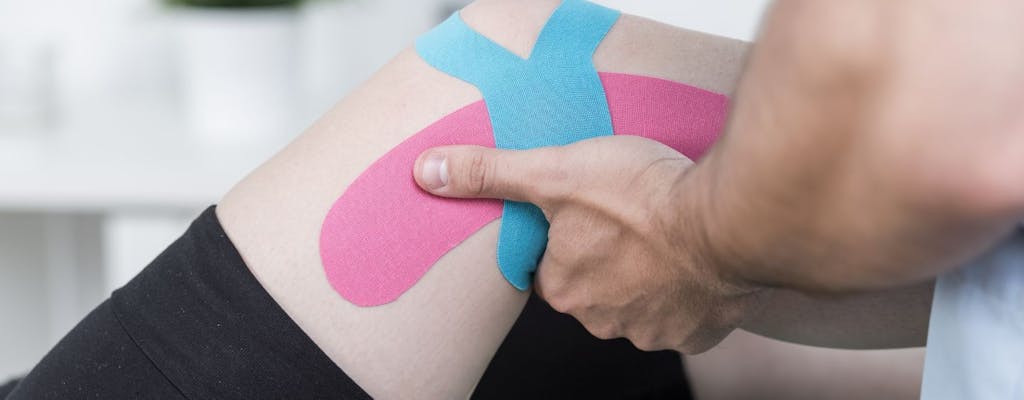
Kinesio® Tape is a latex-free, elastic, cotton tape used for treating athletic injuries and a variety of other physical issues. Kinesio® Tape stretches up to 140% of its original length, which allows for a much greater range of motion than traditional, white athletic tape. It can also be left on for longer periods (up to four days) before reapplication is needed. Kinesio® Tape is a similar thickness to skin and is designed to mimic the skin’s elastic properties.
Opposite of the traditional McConnell Taping Method that uses tape to restrict motion to prevent further injury of a muscle or joint, the Kinesio® Taping Method involves applying Kinesio® Tape to facilitate the body’s natural healing process while providing support and stability to muscles and joints without restricting the body’s range of motion. It also provides extended soft tissue manipulation to prolong the benefits of manual therapy administered within the clinical setting. The tape helps to alleviate pain, reduce inflammation, relax muscles, enhance performance, and help with rehabilitation as well as supporting muscles during sporting events.
The Four Major Functions of Kinesio® Tape:
- Supporting the muscles, improving their ability to contract even when weakened, thus reducing pain and fatigue and muscle cramping and over-extension/contraction
- Improving blood and lymphatic circulation and reducing inflammation and chemical buildup
- Activating the endogenous analgesic system, through which the body can consciously self-regulate pain
- Correcting joint problems, improving range of motion and adjusting misalignments caused by tightened muscles
Kinesio® Taping Techniques:
- The "Y" Cut: Most commonly used; used to surround muscles, such as the deltoid (the muscle forming the rounded contour of the shoulder), to inhibit or facilitate stimuli
- The "I" Cut: Used for acute injuries in small or linear places, such as the rhomboid minor (the small, skeletal muscle on the back that connects the scapula with the vertebrae of the spinal column), to reduce edema (swelling caused by fluid collecting between the cells of the body) and pain
- The "X" Cut: Used on muscles that change depending on movement, such as the biceps femoris (a two-headed muscle located on the back of the thigh that causes both hip extension and knee flexion)
- The "Fan" Cut: Able to cover large areas and flexible in position; commonly used to treat lymphedema (the congestion of lymphatic fluid) by acting as a pump continuously stimulating lymph circulation and to decrease edema (swelling)
- The "Donut" Cut: Used primarily for edema (swelling) in a focal or sport-specific area; overlapping strips are used and the center is cut over the area being treated
Applying Kinesio® Tape:
Correct tension is key to success with Kinesio® Tape. For injured or overused muscles needing relief and healing from pain and tightness, the tape is applied with no tension, starting from the tendons that hold the muscle to the bone and extending toward the origin of the muscle. For chronically injured or weakened muscles needing support and full range of motion, the tape is applied with light tension, starting from the origin of the muscle and extending toward the tendons that hold the muscle to the bone. Because the amount of tension is critical to its effectiveness, Kinesio® Tape is best applied by a certified practitioner, and only after a proper evaluation has been performed by qualified health professionals. In some cases, the treatment of a patient’s condition may also require treatment of other underlying conditions.
Kinesio® Tape must be applied to dry skin that is free of oils, sweat, and lotions. Otherwise, the tape will lose its adhesive abilities. After application, the tape is rubbed to activate the heat-sensitive glue. It takes approximately 30 to 60 minutes for the glue to become fully activated, so the patient should wait a minimum of that time before being physically active or taking a shower. Otherwise, the tape may come off. Small amounts of body hair will not interfere with the effectiveness or adhesion of the tape, though areas with significant amounts of hair should be clipped or shaved for best results and less pain when the tape is removed.
Maintaining Kinesio® Tape:
During the first few days, if an edge of the tape has begun to lift, it can be trimmed. Rounding the edges may help prevent the edges from lifting prematurely. To dry tape after exercising, swimming, or showering, the tape may be patted gently with a towel. The tape should not be dried with a hair dryer as the adhesive is heat-activated and may become difficult to remove.
Removing Kinesio® Tape:
Ideally, Kinesio® Tape is removed by a certified practitioner to reduce the risk of re-injury or of causing new injuries as a result of incorrect removal. Kinesio® Tape is generally easiest to remove when the tape is moist, such as after a bath. The tape should be removed from the top down, in the direction of the body hair, to limit any discomfort and skin irritation.



